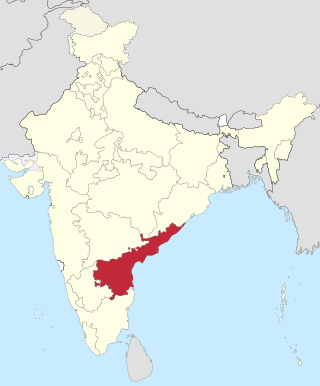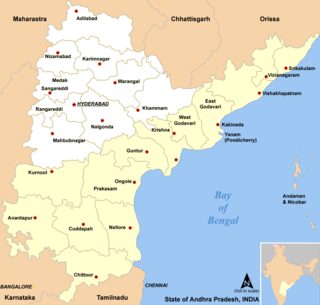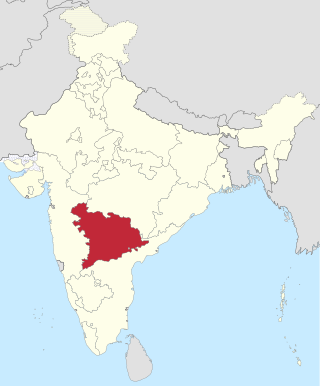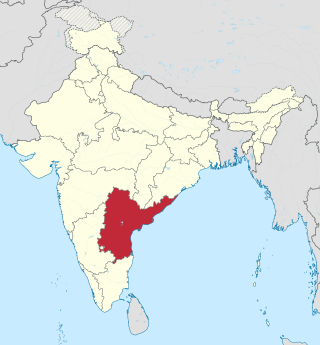
India is a federal union comprising 28 states and 8 union territories, for a total of 36 entities. The states and union territories are further subdivided into 806 districts and smaller administrative divisions.
The Indian Republic held its first elections in 1951–52.

Mysore State, colloquially Old Mysore, was a political territory within the Dominion of India and the subsequent Republic of India from 1947 until 1956. The state was formed by renaming the Kingdom of Mysore and Bangalore replaced Mysore as the state's capital. When Parliament passed the States Reorganisation Act in 1956. Mysore State was considerably enlarged when it became a linguistically homogeneous Kannada-speaking state within the Republic of India by incorporating territories from Andhra, Bombay, Coorg, Hyderabad, and Madras States, as well as other petty fiefdoms, It was subsequently renamed Karnataka in 1973.

Andhra State was a state in India created in 1953 from the Telugu-speaking northern districts of Madras State. The state was made up of this two distinct cultural regions – Rayalaseema and Coastal Andhra. Andhra State did not include all Telugu-speaking areas, as it excluded some in Hyderabad State. Under the State Reorganisation Act of 1956, Andhra State was merged with the Telugu-speaking regions of Hyderabad State to form Andhra Pradesh.

The Gentlemen's agreement of Andhra Pradesh was signed between Telangana and Andhra leaders before the formation of the state of Andhra Pradesh of India on 20 February 1956. The agreement provided safeguards with the purpose of preventing discrimination against Telangana by the government of Andhra Pradesh. The violations of this agreement are cited as one of the reasons for formation of separate statehood for Telangana.
The States Reorganisation Commission of India (SRC) constituted by the Central Government of India in December 1953 to recommend the reorganization of state boundaries. In September 1955, after two years of study, the Commission, comprising Justice Fazal Ali, K. M. Panikkar and H. N. Kunzru, submitted its report. The commission's recommendations were accepted with some modifications and implemented in the States Reorganisation Act in November, 1956. The act provided that India's state boundaries should be reorganized to form 14 states and 6 centrally administered territories. On 10 December 1948, the report of Dar Commission was published but the issue remained unsolved.

1969 Telangana Agitation was a political movement for the statehood for Telangana region. The first person to raise the issue of Telangana happened in 1968 during October or November. A hunger strike was being carried on by a person named Ravindranath on8 January 1969 in Khammam near the Railway Station. He was on an indefinite fast and his prime demand was to implement Telangana safeguards. One other demand was his insistence on implementation of the Gentleman's agreement. It is a major event in Telangana movement. In the indiscriminate police firing, 369 Telangana students were killed.

The history of the Telangana movement refers to the political and social conditions under which the Telangana region was merged with Andhra State to form the state of Andhra Pradesh and the subsequent demands to reverse the merger to form a new state of Telangana from united Andhra Pradesh.

Hyderabad State was a state in Dominion and later Republic of India, formed after the accession of the State of Hyderabad into the Union on 17 September 1948. It existed from 1948 to 1956. Hyderabad State comprised present day Telangana, Marathwada and Hyderabad-Karnataka

The States Reorganisation Act, 1956 was a major reform of the boundaries of India's states and territories, organising them along linguistic lines.

Elections to the Legislative Assembly of the Indian state of Hyderabad were held and Sri Burgula Rama Krishna Rao took oath as First Chief Minister of Hyderabad State on 6 March 1952. 564 candidates competed for the 175 seats in the Assembly. There were 33 two-member constituencies and 109 constituencies single-member constituencies.
Elections to the Andhra State Legislative Assembly were held on 11 February 1955. 581 candidates contested for the 167 constituencies in the Assembly. There were 29 two-member constituencies and 138 single-member constituencies. The members of the first assembly (1955–62) were allowed a seven-year term. That is to say, in 1957, elections were conducted in the newly added region of Telangana alone, and then in 1962, general elections were held for the state as a whole.
The 1957 Andhra Pradesh Legislative Assembly election were held on 25 February 1957. 319 candidates contested for the 85 constituencies in the Assembly. There were 20 two-member constituencies and 65 single-member constituencies. The members of the first assembly (1955–62) who were elected in the 1955 election were allowed a seven-year term. That is to say, in 1957, elections were conducted in the newly added region of Telangana alone and then in 1962, general elections were held for the state as a whole.

Andhra Pradesh, retrospectively referred to as United Andhra Pradesh, and Undivided Andhra Pradesh, was a state in India formed by States Reorganisation Act, 1956 with Hyderabad as its capital and was reorganised by Andhra Pradesh Reorganisation Act, 2014. The state was made up of three distinct cultural regions of Telangana, Rayalaseema, and Coastal Andhra. Before the 1956 reorganisation, Telangana had been part of Hyderabad State, whereas Rayalaseema and Coastal Andhra had been part of Andhra State, formerly a part of Madras Presidency ruled by British India.













